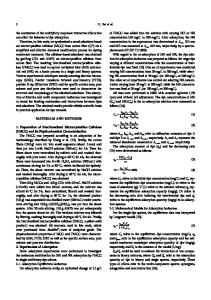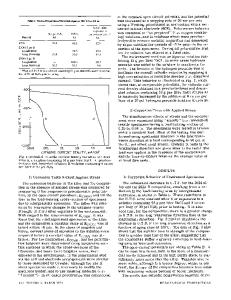Manganese ferrite/porous graphite carbon nitride composites for U(VI) adsorption from aqueous solutions
- PDF / 1,546,093 Bytes
- 15 Pages / 595.276 x 790.866 pts Page_size
- 42 Downloads / 337 Views
Manganese ferrite/porous graphite carbon nitride composites for U(VI) adsorption from aqueous solutions Yujie Ge2 · Zhiqiang He2 · Jiao Wu2 · Guohua Wang2 · Shuibo Xie1,2 · Jinxiang Liu1 Received: 21 February 2020 © Akadémiai Kiadó, Budapest, Hungary 2020
Abstract Manganese ferrite/porous graphite carbon nitride composites ( MnFe2O4/porous g-C3N4[PCN]) were synthesized by templateassisted thermal polymerization and hydrothermal method and applied for high adsorption of U(VI) from aqueous solution. Results indicated that the maximum adsorption capacity of MnFe2O4/PCN (MPCN) was 367.9 mg g−1 under optimum conditions (pH = 5, t = 15 min, and T = 308 K), which was higher than that of g-C3N4 (185.1 mg g−1). Adsorption was well fitted with Langmuir isotherm model and pseudo-second-order kinetic equation. Thermodynamic analysis showed that adsorption is an endothermic, spontaneous process. X-ray photoelectron spectra revealed that amino and metal oxygen groups are involved in the complexing adsorption of uranium. Adsorption efficiency remained 92.5% after five adsorption–desorption cycles. The results of this paper indicated that MnFe2O4/PCN composites can be efficiently used as an ideal material for U(VI) adsorption. Keywords Magnetic · Porous graphite carbon nitride · U(VI) · Adsorption
Introduction An increasing amount of radioactive pollutants (uranium) inevitably enters the water environment With the extensive development and utilization of nuclear. However, uranium is a radioactive, toxic heavy metal, and its emission poses a serious threat to human health [1, 2], Hence, uranium in aqueous solution must be treated. Surveys reported that many physical–chemical technologies, including ion exchange, chemical precipitation, catalytic reduction, and adsorption have been used for U(VI) removal [3–5]. Among these methods, adsorption has attracted the wide attention of researchers with its advantages of convenient preparation method, low energy consumption, high treatment efficiency, and environmental friendliness [6, 7]. In recent years, numerous adsorbents, including graphene oxide, metal organic framework, polymer materials, clay * Jinxiang Liu [email protected] 1
Hunan Provincial Key Laboratory of Pollution Control and Resources Technology, University of South China, Hengyang 421001, China
School of Civil Engineering, University of South China, Hengyang 421001, China
2
minerals, metallic oxides were developed for radionuclide removal [8–12]. However, weak adsorption capability, high cost, and poor chemical stability limit their application as adsorbents. Graphitic carbon nitride (g-C3N4) is an engaging adsorbent with environmental friendliness and, thermal and chemical stability [13]; many amino, imino, and pyridine groups on its surface exhibit high adsorption capacity for heavy metals [14]. However, g-C3N4 is synthesized via thermal polycondensation by cheap nitrogen-carbon precursors [15–17]; its layered structure leads to a small specific surface area, which limits its further development for adsorp
Data Loading...











